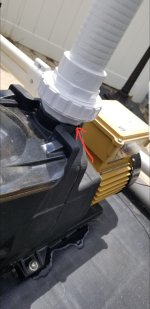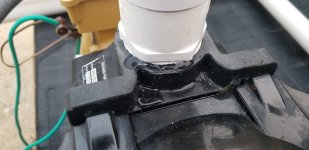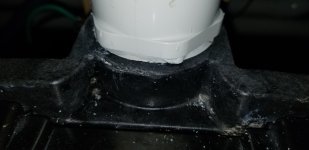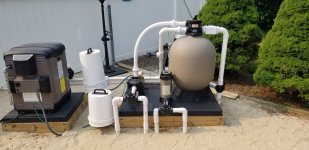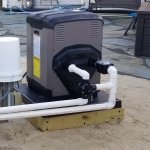I redid some of my plumbing this season because of some leaks at the multiport valve at at the pump, and I wound up using some Hayward Unions directly into the return on the multiport valve as well as the discharge side of the pump. Previously there were no unions anywhere. The male threads of these unions just went in too easy, though, both on the multiport valve and the pump. I used this thread sealant. The unions just bottomed out easily just by hand. As I was doing it, it just didn't feel right. It was too easy. (I feel like the male threads on these unions are too short and slightly undersized) After I let this particular sealant set for 24 hours just to be on the safe side, I turned everything on and sure enough it was leaking there. I did this like three times, removing everything, cleaning everything really well, reapplying the sealant, etc. I just kept getting leaks. I used the same blue sealant on a threaded male adapter into the multiport valve and that one was fine, no leaks. That one got tight as I screwed it in by hand, and I went 1 turn past hand tight with a band clamp.
After being completely fed up with this I called my pool guy who opens and closes my pool. He came and we discussed him just using a male adapter, short piece of pipe, and a slip union instead to go into these trouble ports. He used white teflon tape and Pertmatex white thread sealant. He managed to solve the leak on the multiport valve but not on the pump, that is still leaking. He said he did it correctly and maybe there is a crack there on the pump housing, but I don't know. I feel like it's still coming out of the threaded area there. If the housing was cracked, you would probably see a split, no?
Anyway, I am looking to get some suggestions from you all. Here are a bunch of questions:
1. Should I take it apart again and do it like he did, white teflon tape and white thread sealant?
2. Should I abandon all of this and look into some hi-temp unions with an o-ring at the base and thread directly into the pump again? Something like this. The threads on this look so short as well, but I guess that bottom o-ring is supposed to be doing all the work.
3. Is a leak on the discharge side such a big deal? Like if I just left it like this for the season, I am just losing a bit of water and that would be all? Is there anything else I should be worrying about if I leave it like this? Any damage to the pump that I can cause leaving it leaking as it is?
I attached some pics of my setup. There's a before pic with my union directly threaded into the pump and an after pic with a male adapter in there. I also have a pic of where the leak is evident after I wiped the area dry with a paper towel. It's a small and slow leak but does accumulate there and eventually runs under the pump after running for a day.
After being completely fed up with this I called my pool guy who opens and closes my pool. He came and we discussed him just using a male adapter, short piece of pipe, and a slip union instead to go into these trouble ports. He used white teflon tape and Pertmatex white thread sealant. He managed to solve the leak on the multiport valve but not on the pump, that is still leaking. He said he did it correctly and maybe there is a crack there on the pump housing, but I don't know. I feel like it's still coming out of the threaded area there. If the housing was cracked, you would probably see a split, no?
Anyway, I am looking to get some suggestions from you all. Here are a bunch of questions:
1. Should I take it apart again and do it like he did, white teflon tape and white thread sealant?
2. Should I abandon all of this and look into some hi-temp unions with an o-ring at the base and thread directly into the pump again? Something like this. The threads on this look so short as well, but I guess that bottom o-ring is supposed to be doing all the work.
3. Is a leak on the discharge side such a big deal? Like if I just left it like this for the season, I am just losing a bit of water and that would be all? Is there anything else I should be worrying about if I leave it like this? Any damage to the pump that I can cause leaving it leaking as it is?
I attached some pics of my setup. There's a before pic with my union directly threaded into the pump and an after pic with a male adapter in there. I also have a pic of where the leak is evident after I wiped the area dry with a paper towel. It's a small and slow leak but does accumulate there and eventually runs under the pump after running for a day.


